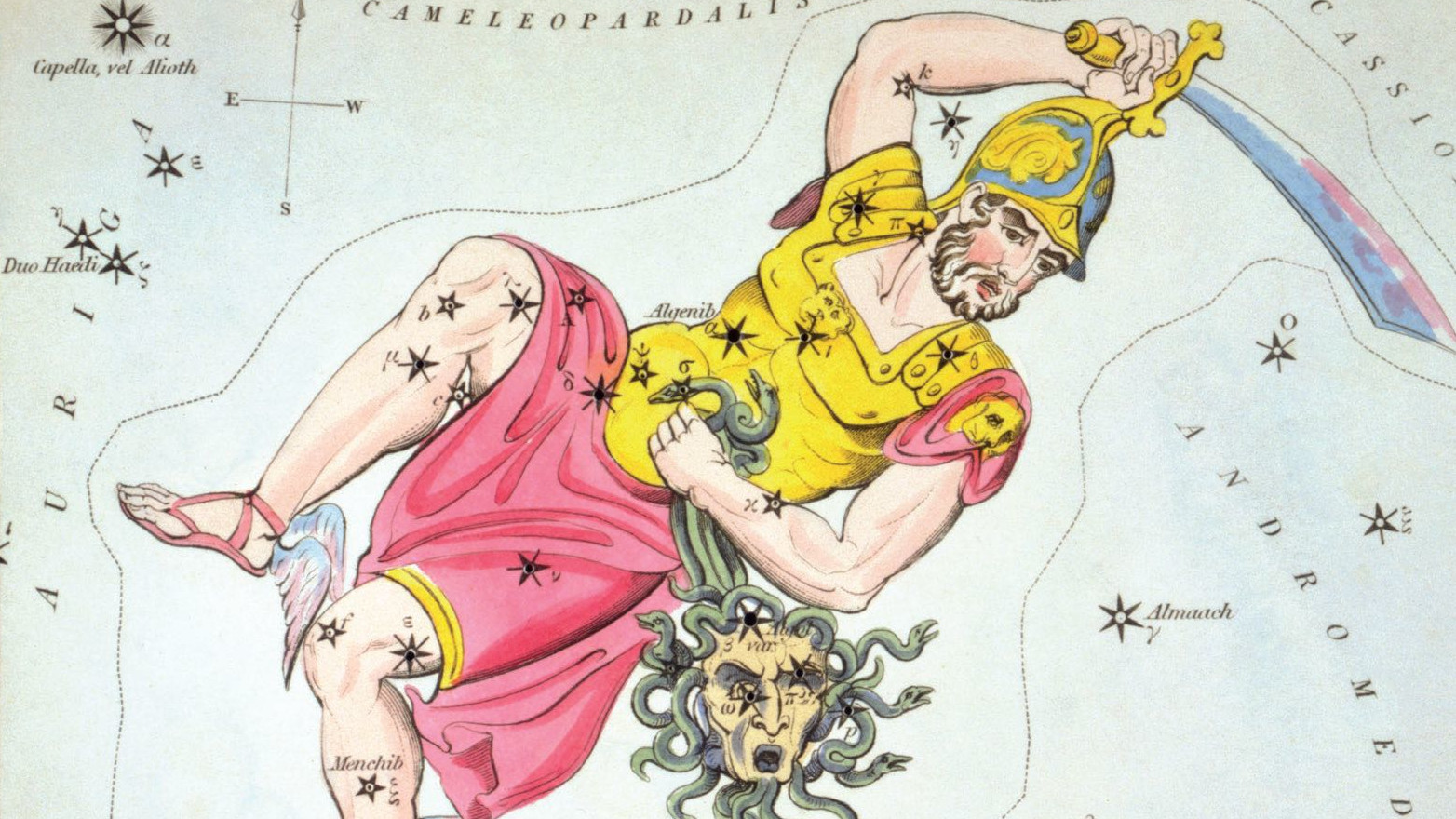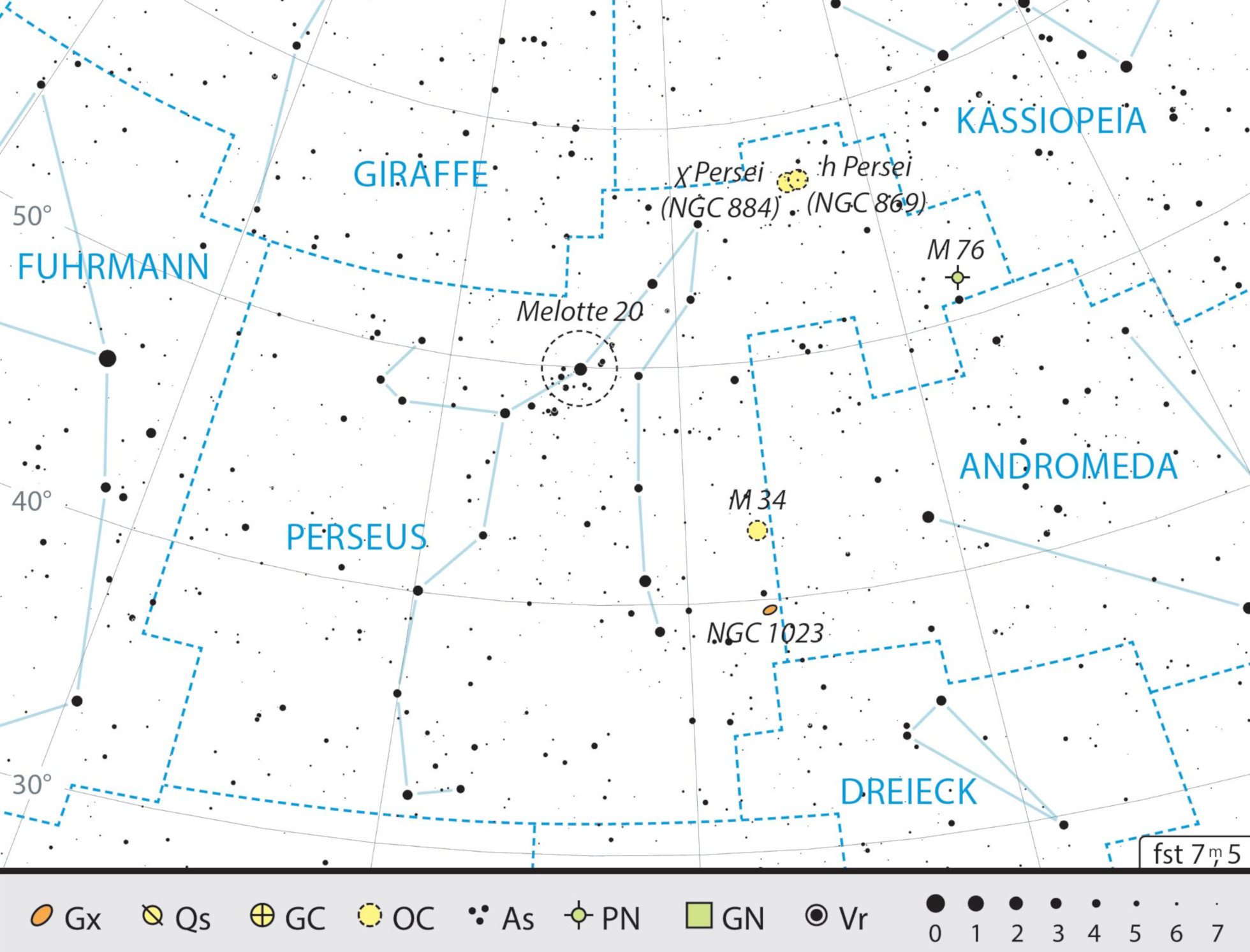Perseus
A prominent meteor shower every August, the double cluster "h & chi" and the famous variable star Algol.
 Visual representations of the constellation show the hero Perseus with the severed head of Medusa, symbolised by the star Algol.
Visual representations of the constellation show the hero Perseus with the severed head of Medusa, symbolised by the star Algol.In the large region of the sky between Andromeda, Auriga and the W-shaped Cassiopeia you will find a figure that resembles an upside-down letter Y – this is the constellation of Perseus. It is associated with one of the most famous stories from Greek mythology: in far-away Ethiopia, the beautiful Andromeda, daughter of the royal couple Cepheus and Cassiopeia, was to be sacrificed to a sea monster thanks to her mother’s vanity. But she was saved by Perseus, who produced Medusa’s severed head from a sack.
Medusa was a gruesome creature with glowing eyes, long canine teeth, scaly skin, and snakes in place of hair. All living creatures that saw her turned to stone. But Perseus used the image reflected in his shiny shield to behead Medusa. Using Medusa’s head, Perseus turned the sea monster to stone, and it sank to the bottom of the ocean. All the figures from this legend can be seen in the autumn sky: Perseus and Andromeda, Cepheus and Cassiopeia, the sea monster Cetus (the constellation of Cetus) and even Pegasus, the flying horse, who was born from Medusa’s blood.
The Demon Star and some meteors
The hero Perseus carrying Medusa’s severed head is also depicted in the stars. It is symbolised by the bright star β Per, named Ras al-Ghul (head of the demon) by ancient Arabic astronomers, which became known as Algol over the centuries and millennia that followed. Around 1670, it was discovered that this star does not shine with constant brightness. More than a century after the discovery of Algol's variability, it was childhood friends Edward Pigott and the deaf John Goodricke who observed the changing star over a longer period of time, and were able to determine that the period of variation of its light was around three days. The two amateur astronomers thought it possible that the regular decrease in brightness of the Demon Star could be caused by a circling body or a planet that was half the size of the star itself. Later, however, it turned out to be a stellar eclipse in which two stars occult one another.
The constellation is also well-known in the media as the location of the radiant of a meteor shower which reaches its peak every year around 12 August: the Perseids. They are also known as the Tears of Saint Lawrence.
Near and far
The deep sky highlight is undoubtedly the double cluster h and χ Persei, which is often simply known as “h and chi Persei”. It’s visible even with the naked eye as an elongated fleck, and is an exciting target for binoculars in particular. The oldest description of the object can be found in a chronicle from ancient China. More than 4,100 years ago it was regarded as a warning sign, because this double cluster represented the court astronomers Hi and Ho who, having failed to predict a solar eclipse, were condemned to death by the emperor. The open cluster M 34 and the planetary nebula M 76 are other worthwhile destinations.
The Melotte 20 open cluster is less well known, and is best seen with the naked eye or through an instrument with a wide field of view, due to its size of at least three degrees across. Most of the stars gather south of the brightest star, α Per. The constellation has yet more to offer, with galaxies (NGC 1023) or the Perseus Cluster (Abell 426), however these are only accessible with medium-sized or larger telescopes.
 Outline map of the constellation of Perseus with our observing recommendations. J. Scholten
Outline map of the constellation of Perseus with our observing recommendations. J. ScholtenAuthor: Nico Schmidt / Licence: Oculum-Verlag GmbH
